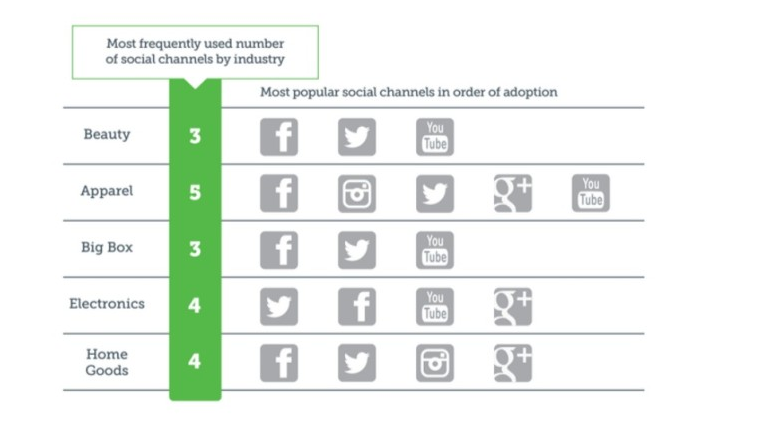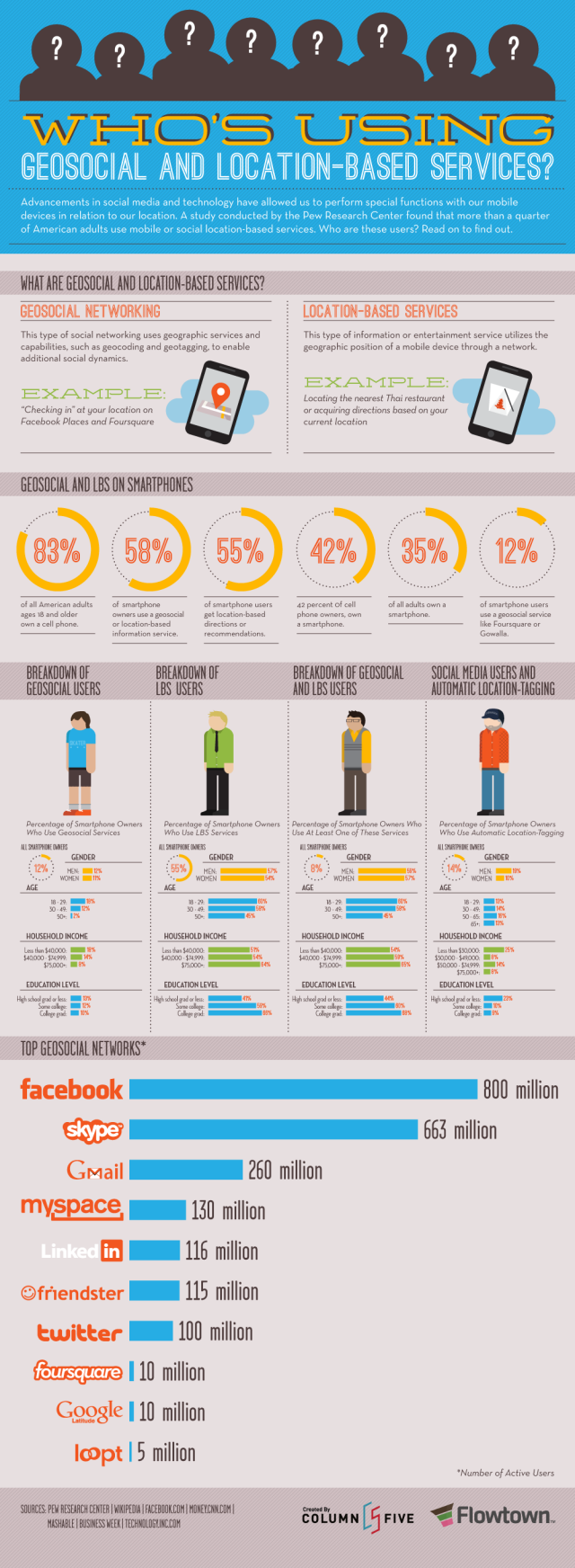Optimising social channels for retail
July 3, 2015
A recent study tracked the social media usage of 50 top US retail brands across 5 categories: beauty, apparel, electronics, big box and home goods.
http://www.adweek.com/socialtimes/yesmail-retail-brands-social-media-channels/622117
Data from Yesmail:
As can be seen from the above graphic, Facebook is still the most popular network and is used across all categories, from beauty, to apparel, to home goods. Facebook’s ubiquitous nature keeps it at the forefront of brand conversation, and despite strong growth from newer channels, it remains a priority for most companies to engage with their customers.
Although Facebook is a primary channel, from our experience the most effective way to optimise your social performance is to play to the strength of each platform.
Why are big brands continuously using multi-channel social media sites across industries?
– to increase brand awareness and affinity
– to develop a strong reputation and manage damage control
– to drive sales and marketing KPI’s
Superior competitive advantage and hitting business targets is achievable with the right social channel mix.
Creative Workplace: London Social Media Agency
November 28, 2014
A social space for London social media agency | Created by Studio 7 Design.
agency:2 moves into a new, bespoke London office designed for creative inspiration & sociable interaction.
A fab new office has been designed and created by the team at Studio 7 Design for agency:2, run by Joel Davis and Sharon Baker. Studio 7 Design worked quickly and efficiently in order to facilitate a smooth transition from a temporary office in London’s Kings Cross to a new space in Highbury & Islington. The bespoke office space was designed with purpose and flair; all of the elements have come together to create a social space for the social media team.
The ‘Ideas Shed’ was created as a stand-alone structure as there wasn’t scope to build partition walls. It generates atmosphere; it is both aesthetic and purposeful, and fulfils the dream of bringing energy to the workplace. Shifting the outside to the inside also works brilliantly as there is a real feeling of spontaneity and freedom despite its enclosed nature. Skype calls, private meetings or brainstorming sessions can take place in the shed, as it is private yet open to the meeting area.
Sharon says “We wanted a meeting space within the office for the team, so we wouldn’t have to take clients outside of the office. This is where the magic happens. We wanted to encourage spontaneous brainstorming, creativity and have a ‘chill-out’ area for staff to relax when not working.” The Ideas Shed opens to a lounging area which is comfortable and funky.
The paint colours have been chosen specifically to engender certain emotions. Green suggests the outdoors and freedom, blue suggests the sky and the orange is bright and fun, the latter a favourite of both Sharon and Joel. The diagonal lines on the wall break up the square space and give a feeling of openness.
The shelving unit seen as you enter the office is actually an artistic sculpture. It is practical for display purposes but is also free-flowing and creative. There is a strong continuity of materials throughout the office with hand-made textures and finishes, bringing in the natural exterior with deep colours. All the pieces are movable to suit a changing environment.
Other quirky touches include:
- Drinks trolleys are a throwback to the Mad Men era of the sociable ad agency. On Friday afternoons, the wine glasses replace the coffee mugs and an enjoyable end of the week takes place.
- Chalkboard paint allows quick updates to desks and ideas. One wall boasts a changeable board, with the option of posting quotes, to-dos or inspiring messages. Today’s reads: “Welcome! We’re just enthusiastic about what we do.” – Steve Jobs.
- A huge lightbulb painted on the back wall doubles as an ideas hub and a projector screen.
- An astro-turfed section filled with comfy chairs, drinks trolleys and soft lighting is perfect for client meetings and brainstorming sessions. It is a direct nod to a Google styled space, which is known for being up-to-date, adaptive and cool.
The office is fun: Staff feels good upon coming into the office and upbeat when leaving.
Work is not meant to be oppressive: agency:2 prides itself on a close-knit team of happy individuals who work well together. The office space is integral to achieving this closeness.
Creativity needs to be nurtured: Social media is fast-paced and strategy is key. The office space is integral to the meeting of minds and bringing ideas to reality.
For more information on Studio 7 Design visit: www.studioseven.co.uk
Watch the creation happen: http://vimeo.com/111738342
Big Data: The Big Game Changer
June 13, 2014
If you’re a sports fan the next two months will be a golden period for watching sport with the FIFA World Cup, Wimbledon and the Commonwealth Games all taking place. Here are our top three predictions about how Big Data will be a big game changer for these events and how it will affect the future of sport.
1. Better Analytics: There is now a wealth of sports statistics about specific games and players accessible for managers, broadcasters, players and fans alike with real-time data easily accessible. Some of this technology is already enriching fans experiences, and for Wimbledon this year fans will be able to use IBM’s ‘SlamTracker’, which is based on 41 million data points and monitors players’ aces, serve speed, patterns of play, players’ styles, past winners and other key statistics in real time.We live in a multi-stimulus age and fans want real data on not just what is happening, but why. We predict big data will greatly enhance fan experiences in the future, whether this is through Google Glass giving real time data, or having sensors in balls so that fans can be attuned to how weather conditions will affect the curve or bounce of the ball.
2. Wearable Technologies: With team players now equipped with wearable technologies coaches can track their heart rate, lung capacity, metabolism, velocity and distance travelled. Decisions about match substitutions are no longer made by who’s looking tired on the pitch, there’re influenced by real-time biometric data helping managers make informed decisions and prevent players from over-exerting themselves and risking injuries. For conflict sports, such as boxing, this data will be vital to avoid injuries and determine whether fights should be continued.
Big data will not impact live sporting events but can optimise training schedules and impact future strategies and tactics. With ‘smart short’ and ‘smart socks’ already being developed, soon data on muscle fatigue, muscle balance and even if a player has cramp will be available for coaches.
3.Hiring Decisions: In the future we predict that it will be the analytics experts who are the managers and trainers. In sport it is often the smallest changes that make the biggest difference, with sports writer David Epstein explaining “the difference between legendary and anonymity in elite sports is usually less than one percent” and only 0.5 percent separates Usain Bolt from that runner you’ve never heard of (Source: Strata Conf. ‘Making Data Work). It is only through understanding this vast amount of data properly that it can be effectively applied.
Sport is a big business that is perfect for big data. With huge amounts of money invested in big sporting events there are definitely the resources available to utilise big data effectively. Some sports, such as Formula One Racing are already applying this data to great success, others are slower to adopt these changes, but it’s only a matter of time until big data starts being a big game changer for every sport.
Facebook and Mobile Usage 2013 Predictions
November 19, 2012
Mark Zuckerberg recently proclaimed at the TechCrunch Disrupt conference that he believed that Facebook’s future lay with mobile devices: “We think we’ll make a lot more money than on desktop”. With click-through rates already 14 times higher on mobile devices this news is hardly unexpected. Zuckerberg admitted past mistakes Facebook had made with mobile apps for multiple devices; yet asserted that his company had learned from these mistakes and Facebook is “now a mobile company.”
With more than half of Facebook users already using mobile devices to access their accounts (including Facebook’s CEO himself), this is a key area for development. It is critical for Facebook to get mobile technology right if they want to secure their success and the loyalty of their investors.
So what should we expect for Facebook in 2013? There have been a number of rumours circulating that Facebook is looking to create its own mobile devices, however Zuckerberg has firmly denied this rumour. We believe that mobile advertising will become increasingly better targeted towards individual users, as Facebook collects more information about users through engagement. What is clear is that Facebook will continue to push new features for brands to drive revenue through mobile ads and that we will see an increase in commercial activity. With Zuckerberg claiming that Facebook is “just getting started” at agency:2 we are eagerly monitoring and responding to each new development.
http://www.sfgate.com/news/article/Zuckerberg-Facebook-future-is-mobile-3858141.php [accessed 12/11/2012].
http://allthingsd.com/20120810/facebooks-future-in-mobile-advertising-its-all-about-wi-fi/ [accessed 12/11/2012].
http://www.sfgate.com/news/article/Zuckerberg-Facebook-future-is-mobile-3858141.php [accessed 12/11/2012].
http://allthingsd.com/20120810/facebooks-future-in-mobile-advertising-its-all-about-wi-fi/ [accessed 12/11/2012].
Social Media in Financial Services: Business Case
July 17, 2012
Social media in financial services is an essential part of the marketing mix, offering financial service organisations the chance to connect with customers and prospects on a personal level and build strong relationships. So what are the opportunities for social media in financial services? We identify 5 business objectives that can be supported with social strategy on DMA’s blog.
Find your ABC1s through location based services
May 10, 2012
The folks at Flowtown have cut through the data on users of geo-social networking and location-based services to produce this infographic – and guess what? it’s the under 30 year old males that lead the way. Delving a little further into the whos and whats shows us that users with spending power look to location-based services to find out what brands can offer them. And with the data showing that those people most likely in the US to access these services on their smartphones are in the higher – the learning for brands is that location-based services can help you find your target market.
Cookie Best Practice
April 20, 2012
From 26 May 2012 websites operated in the EU will be required to inform their users that they are being tracked with cookies, and to ask users for their consent. There’s much that brands can do to support site architecture changes by reviewing how they relate to their B2B and B2C customers in two areas:
1. Transparency
Businesses using cookies must be completely transparent in how they collect, store and use data.
Make sure your privacy policy is up to date and that you’ve provided information on how to reject or delete cookies. By making it clear you’re using them, what they are being used for and how users can control them, you’ll educate people about how they are essential for personalisation.
2. Responsibility
Data must be used responsibly. There has been very little misuse of cookies by B2C and B2B companies and this must continue.
Businesses must be aware of all cookies utilised within their website – the legislation includes both your own cookies as well as cookies set by a third party. So remember, you are responsible for all cookies on the site and ensuring they comply with the legislation.
Ultimately, when used responsibly and effectively, cookies are an invaluable way of enhancing the user experience and customer satisfaction, as well as providing marketers with a vital tool to improve conversion rates. Transparent and responsible use of such data will safeguard these benefits for both parties.



